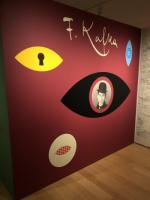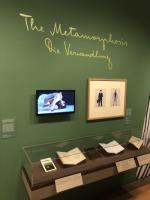Though Franz Kafka never visited New York City, an imaginary version of it is the primary setting of his first abortive attempt at a novel, Der Verschollene (‘The Man Who Disappeared’), which begins with the arrival of young Karl Rossmann into the harbour of New York City. The novel captures Karl’s initial impressions of America through the frenetic and bewildering metropolis of New York: the imposing Statue of Liberty, the traffic-clogged streets and rackety public demonstrations, not to mention the city’s baffling and hostile social systems. New York, in Kafka’s rendering, is stark, a challenging place, often unwelcoming for its protagonist. This portrayal stands in stark contrast to the way the city has embraced Kafka’s legacy in the hundred years since his untimely death in the summer of 1924.
New York City’s vibrant arts scene has long been a home for Kafka’s works. From November 2024 to April 2025, the Morgan Library & Museum in New York City hosted a major exhibition dedicated to Franz Kafka. This exhibition, a collaboration with the Bodleian Libraries at the University of Oxford, commemorated the centenary of Kafka’s death. In its original Oxonian format, it was entitled Kafka: Making of an Icon; in New York, it was simply Franz Kafka. Though perhaps more traditional in its layout than the vitrine installations in Oxford’s Weston Library (many exhibits in New York were framed and hung rather reverentially on the walls of the gallery), the Morgan’s exhibition was also vibrantly decorated, given the Library’s use of the eye-catching original covers for Kafka’s books from the Schocken Publishing House. The inclusion of Ross Benjamin’s translations of Kafka’s diaries and other materials was also an added bonus.
Situated on the busy and glamorous thoroughfare of Madison Avenue, the Morgan exhibition boasted an array of Kafka’s original manuscripts, letters, diaries, and photographs, displayed to the public alongside original artwork by Andy Warhol. This marked a poignant moment in the century of Kafka reception worldwide, as many of these invaluable items from the Bodleian (the custodian of the majority of Kafka’s archive) were being shown in the U.S. for the first time. Like its earlier Oxford incarnation, the exhibition at the Morgan explored Kafka’s enduring influence on literature, art, and culture, and examined how his work achieved the iconic status it occupies around the globe today, though the astonishing artwork by Tessa Farmer from the original Oxford exhibition was too fine and delicate to travel across the Atlantic and be included.

Curated by researchers from the Oxford Kafka Research Centre including Carolin Duttlinger, Katrin Kohl, Barry Murnane, Meindert Peters, and Karolina Watroba, in collaboration with the Morgan Library’s curator Sal Robinson, the exhibition aimed to provide a comprehensive look at Kafka’s life and work, moving beyond the common perception of him as a tortured and isolated figure. It examined his personal relationships, his struggles with his various ethnic and linguistic identities, and the social and historical context in which he wrote. Key exhibits included the original manuscript of one of Kafka’s most famous stories, ‘Die Verwandlung’ (often translated as ‘The Metamorphosis’), as well as the manuscripts of his novels Der Verschollene and Das Schloß, and personal letters to his sister Ottla. (The manuscript of Der Proceß, ‘The Trial’, is held at the German Literature Archive in Marbach, which simultaneously mounted its own Kafka exhibition, running until summer 2025).
When the AHRC-funded ‘Kafka’s Transformative Communities’ project team (Carolin Duttlinger, Ian Ellison, Katrin Kohl and Barry Murnane) visited the exhibition in February, it was regularly packed with visitors from New York City and further afield, including alumni from Jesus, St John’s, and Wadham, whom we were delighted to show around the exhibition space. The New York iteration of exhibition was extremely well received, with critics noting the depth and sophistication of its commentaries on Kafka’s life and work, alongside the truly rare opportunity it provided to view Kafka’s original manuscripts. Writing in the New York Review of Books, Deborah Eisenberg, noted how ‘the sheer physical fact of these papers, the intimate small shock of the handwriting, of a word or phrase crossed out, the irrefutable existence of a time that once existed in exactly the same materiality as ours, is at moments uncannily effective.’

A final event rounded off the AHRC Kafka project’s New York excursion: a thrillingly interdisciplinary public workshop at Columbia University’s Deutsches Haus, organized by Mark Anderson. Carolin Duttlinger spoke about Kafka and the dream of flying alongside Barry Murnane, whose paper considered Kafka and the golem. Katrin Kohl gave paper on bridges and narrative destabilization in Kafka, followed by Columbia graduate student Luca Arens who analysed Kafka’s flat characters. I was fortunate enough to share a panel with Kafka translator Ross Benjamin: he offered some reflections on the thresholds of writing encountered in translating Kafka’s diaries, while I spoke about figuring Kafka’s posthumous authorship. Our host Mark Anderson discussed echoes of Robinson Crusoe in Kafka’s work, while Mark Christian Thompson presented his research on vaudeville and blackness in Kafka’s late short fiction. The event was well attended by around 50 graduate students, postdocs, and faculty members from several of New York’s universities.
Elsewhere in her exhibition review, Deborah Eisenberg wrote: ‘Most mysterious is the tensile strength of the pieces. Nothing feels arbitrary or random or empty. The integrity, the inner coherence, is—though unfathomable—unassailable.’ To my mind, in fact, the experience of bringing Kafka’s materials and the work of the Oxford Kafka Research Centre to New York City is a hopeful exercise in attempting to make the man and the work somewhat less unfathomable, but no less fascinating for that.